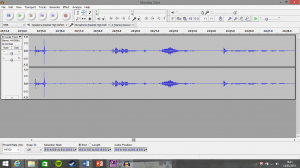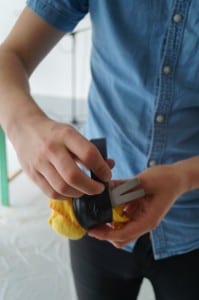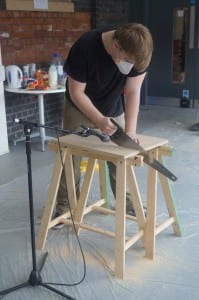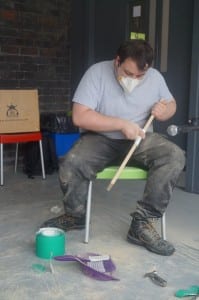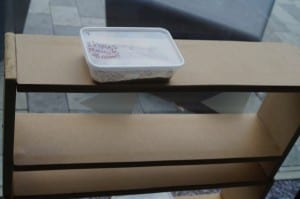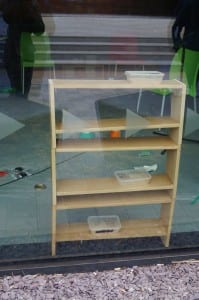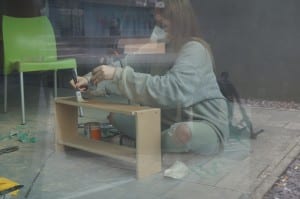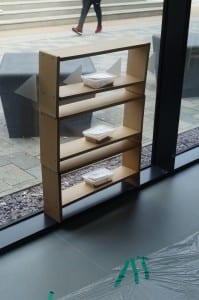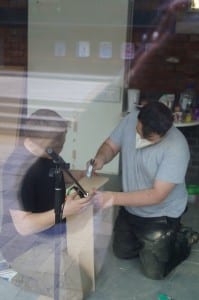Framing Statement
Our group – ‘Shelved’ – will be doing a site specific, intermedia, durational performance installation. It will be all based in the Freezone as well as outside the window in the Freezone. We will aim t do a full 9-5 performance, as though doing a full working day. It will be an exploration of the history of the library as a warehouse and as library. To do this, we will be building shelves. This explores the history of when it was a warehouse through the labour that took place, and by building shelves, we intend to bring the labour back. By building shelves, one of the most common things seen in a library, we will explore the library aspect through building them as quietly as possible as well as archiving the sawdust produced from the shelves.
It will be very much intermedia because of the fact that there will be a fair amount of technology involved in the piece; microphones, sound desk, wireless headphones. This aspect, the sound, has an influence from Janet Cardiff’s 40 part Motet (which can be seen by following the link below):
https://www.youtube.com/watch?v=ncWFLzVrwU4
There would be an influence from this as we would like to show something similar in terms of taking a sound or sounds from one place and put it elsewhere. For us, this would mean taking the sounds of a workshop from a warehouse setting (this is what the library previously was) and put it into a library setting. As well as this, we intend to get the audience involved by listening to the sound we create by giving them headphones, so this further takes the sound out of the warehouse/library setting.
By giving the audience wireless headphones, it also get them to listen to what is happening and get them to actually listen to what is happening as oppose to them thinking it’s just noise pollution, another theory we’ve looked at. By telling the audience to listen properly, it tells them not to shut out the noise and listen, not hear.
What they will hopefully be listening to will be a live soundscape of a workshop setting. The microphones we will be using will go as close as possible to whatever activity they are focusing on so that the audience can hear a close up perspective of varnishing over sawing. Listening to the strokes of the brush. The sound desk will be used to mix the sounds so that one can be louder than another, hence why they will hopefully be able to hear the brush just as much as the saw or hammer.
The boxes of sawdust will be links to artist’s books as we are calling the boxes of sawdust books. By categorising them on the shelves, we give them a purpose similar to actual books, plus they represent the shelves too and how long it will take to build them or how loud we were whilst making them. This is almost a form of data collection.
Reaction to the Library as a Performance Space
I normally tend to think of the library as a studious place where some social interaction is allowed (well, in the university library), but I hadn’t considered it as a place to perform, even if we all are performing in that space without consciously knowing or thinking about it. A performance in the library isn’t something that comes naturally to ones thought process, so the ideas that first sprouted to mind consisted of possible social experiments and the breaking of library rules – particularly on the third floor where you HAVE to be silent.
It was this idea of breaking the rules, being rebellious in the library that got me thinking about the more extreme possibilities of what can be done in the library, for example, being purposefully loud on the third floor so that eventually someone will come and tell you to be quiet as the rules are very strict.
However, the first idea that came to mind was something that wasn’t anywhere associated with the libraries history or the purpose of a library, nor was it appropriate for the time of the year. I wanted to use a whole floor and just use it as a haunted library-come-scare fest; something that I knew would be out of the question but would be incredibly fun. After having a couple of sessions of watching videos in seminars and the reading we have done, the ideas of what could be done were increased further. I particularly liked a video we watched of a group of people wrapping the Reichstag as, for me, it made me question why they did it. The whole idea of wrapping something well known, or maybe something not so well known, is something that makes that object a blank canvas that anybody could envisage what the building really looks like or what it could look like in their heads, different to what it actually looks like. This is something that I certainly found intriguing, at first.
As I have previously said, it wasn’t something that comes naturally to yourself when you think of a library, therefore, ideas for this project came few and far between at this early point because there was so much to take into consideration: the architecture, the history, and the uses of the library. So it is relatively difficult to decide at first because of the amount of different aspects of the library it is possible to focus on and create something on or around. For example, it’s possible to focus on why people use the library or the people within the library rather than the library as an object or building itself. As much as this appealed to me, to do a sort of social observation, it was something that I didn’t think would be as challenging as what I would have liked.
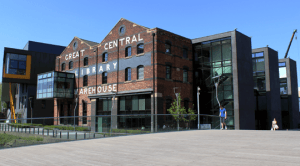
Theatre & Architecture: Introduction
In Juliet Rufford’s book, the introduction makes some valid points but, also some interesting points too that show the progression of architecture through the different periods of drama: early Greek theatre, the Restoration period and the modern era of theatres and the architectures influence over theatre.
Rufford notes that the change in architecture of theatres had a link to the change in the audience, which could ultimately change what happens on the stage. This can be seen from ‘the huge size of the ancient Greek amphitheatre [that] demanded large gestural acting.’ (Rufford, 2015, 3) In this period of time, the audiences would be huge and they attended open aired theatres, therefore the actors had to project much more, this is also the reason for the larger gestures on stage. However, Elizabethan theatres, by way of contrast, were much smaller, and from the Globe theatre to the Theatre Drury Lane, there were changes that included going from open aired theatres to indoor theatres, mostly stood to everyone being sat and natural lighting to artificial lighting.
From open aired theatres to the indoor theatres, the architecture of the theatre influences the acting and theatricality because the actors didn’t have to project their voices as much, because their voices aren’t disappearing into the open air. Therefore, the newer architecture of the indoor theatres forced the audience to listen, even if in the Restoration period the audience openly criticised the actors on stage during the performance, but this gave way to the parameters of the contemporary theatres we expect to see today.
‘But perhaps the most significant change of all was that the auditorium lights were turned down… [and]…in the dark, the sights and sounds of the auditorium were stilled.’ (Rufford, 2015, 6) This change in 1876 by Richard Wagner for his Bayreuther Festspielhaus was a game changer in how architecture influenced the way people acted at the theatre. In the Restoration period, the stage and audience were lit in equal lighting because of a lack of technology, although it was cutting edge for its era. Despite the fact no one in the audience would have known to be quiet when the lights went down, it seemed as though it was a natural thing to do, and this was a clear paving stone for what we now expect to see and be a part of in a theatre surrounding.
The technology and the change in design of the theatres have shown how the change in architecture has had a major influence on the expectations from what happens on the stage and the whole theatre experience.
The Performance Process – Part 1
The process through which we have gone has been quite difficult thus far. Attempting to build something in a space that isn’t a workshop requires us to seek out a lot of materials we need, providing difficulties. However, throughout the weeks, there has been a development in our piece: we have gone from wanting to build a scale model of the library and focusing on the history and architecture of the library, to building shelves in the quietest way possible and me monitoring this by microphones around the room; this would also provide a live soundtrack or soundscape of a workshop for the audience to listen as they watch from outside of the Freezone.
Within the workshop, we intend to have a few different things going on at the same time: sawing, hammering, sanding and varnishing. The microphones will be pointed at each of these and connected to a mixing desk which will in turn feed to headphones for the audience to listen to. On the mixing desk, I shall be attempting to make the things you might not hear over others; for example, sawing over hammering, so hopefully, the outcome will be that the live soundscape will provide the audience with sounds they might not necessarily think of hearing or listening to.
When you think of where a workshop tends to be, many people may class this as noise pollution because of all the sawing and cutting and hammering that many people would class as a collective noise rather than individual sounds. However, ‘noise pollution results when we do not listen carefully. Noises are the sounds we have learned to ignore.’ (Kelly, 2011, 110) so by using the mixing desk, the audience will be able to listen carefully to what is happening in front of them. Also, ‘the concept of the soundscape is a broad one, accommodating the complete sound environment in a location and the human response to it.’ (Davies et al, 2013, 224) This is where the headphones come in. As no one but us will be allowed in the room, then the only way for people to hear what is going on will be through the headphones and they will be hearing the ‘complete sound environment’ (Davies et al, 2013, 224) of this workshop environment we will be creating.
Books
Since we are all going to be performing in and around the library, I felt it only natural to write something about books. Not just what we expect from a book, but also inclusion from what we have talked about in seminars where we questioned: What is a book?
So what do we expect from a book? Many pages together to form a novel, or a collection of stories or poems, or something informative. As much as someone may want to avoid books because they don’t like reading, it is hard to avoid them as we grow up with them, we learn from them in school and they can help to shape who we are. In fact, most of us will have had one when we were babies or toddlers and had them read to us from our parents. But also at this early age, they can help us to talk and read, so books are important to us as we grow up.
Books not only help to shape who we are as we grow up, but as we have grown up, we read more and more and learn more and more from the books we read. Even from fictional books we read as teens, the books we class as teen books, can help us understand things socially, help us find ourselves at a time in our lives when we really need to find out who we are. So for me, books are incredibly important to us as humans, so that we can develop and learn.
However, if we look at books from an academic perspective, then they help us learn, but in a completely different way. They help us have an understanding of the wider world and help us form an opinion on matters we may learn about, for example, from a personal perspective on academic learning, I found this in the first lecture for another module. We were told about the politics of teaching and how the arts were basically getting kicked out, and this made me form an opinion of a matter I previously had very little knowledge of.
But as we, as a group, have explored in seminars, books aren’t just something we read, they aren’t just the stereotypical object we fine in libraries or Waterstones, but could be a plastic food box filled with marshmallows and strawberries and inspiring quotes. They can be something we listen to, or even a plastic bottle filled with facts. It’s as if you could do anything and still call it a book, as a book, seemingly, could be anything. Literally anything. Even a plastic tub filled with sawdust.
The Performance Process – Part 2
As the rehearsals have gone on in lesson times, we met up with Darren and discussed the technology that we would be using: the mixing desk, microphones, and headphones. We will also be using either a projector or a TV screen to show the visual aspects of sound.
The programme that will be used so that the audience will be able to see the sound is Audacity. There will be a direct link from a laptop to the screen/projector and this will be in the middle of the room. It’s good to use this as it can help to immerse the audience in the performance as they will be able to hear and see what Billy, Chris and Klaudia are doing, but will also be able to see how loud they’re truly being by the visual element of having a programme that shows them this.
Ultimately, the audience experience of our performance should be about the sound and getting them to listen to the sounds of what is happening in our workshop. We don’t want the audience to just think we are building shelves.
The Performance Process – Part 3
Whilst in rehearsals, we wanted to try different ways of muffling the sound of the tools we wanted to use. Obviously it would be harder to muffle the sounds such as sawing, therefore we thought it best not to muffle the saw and only attempt to saw as slowly as possible to keep the noise down.
We have created a soundtrack of the different ways we muffled the hammer as well as incorporating the sounds of sawing too. There was an exploration of muffling the hammer by using different materials such as sponges and cloths. This is something we intend to incorporate into the final performance.
Performance Evaluation
The final performance on the 9th May went very well. The audience perceived the idea behind our work, creating a workshop and using the idea of what the library once was (a warehouse) and taking the idea of labour from that as well as taking the idea of being as quiet as possible and the arrangement and sorting from the library aspect.
Although the audience numbers weren’t very high for a performance that lasted the whole day, there was consistency provided that I went to people and asked them to listen to what was going on. From the majority of the audience members, there was a lot of positive feedback as the majority of the audience weren’t other drama students. This was because of the time of the year it is when a lot of students use the library to finish essays, etc. off.
The reaction of the audience was very mixed because a fair few people didn’t know a lot about the history of the library. For example, not many people knew that GCW meant Great Central Warehouse or that it was in fact an actual warehouse before it ever was a library.
There were a lot of strengths to what we had done on the day, the main one for us was finally deciding why and how we were categorising the sawdust that came from the sawing and sanding of the shelves. We knew beforehand that we wanted to and the plan was to look at the decibels and see what the highest reached decibel was making that shelf. However, Audacity didn’t really tell us this information so we decided upon timing how long it took us to build the shelves and after we had built the shelf, how long it had taken to get to that point.
In terms of weaknesses and improvements, an improvement on technology in terms of being able to know the decibel level would have been extremely helpful. This would have been very helpful as we would have had our original way of categorising the sawdust on the shelves.
One other thing we hadn’t considered before, but it had been brought up during the performance was that, because I didn’t contribute much to building the shelves and I went around handing the headphones out and explaining what we were doing to the audience, I could have swapped with someone else in our group as they got more tired from sawing or sanding. Not only would this have given other people in the group a chance to see what it was like watching from the outside, but also give each other a break from the work we were doing.
Overall, the performance went very well, the audience’s perception of the idea behind it and what was going on went down very well as most people seemed interested. For the length of time it took to do our performance, the audience were also very surprised at how we were still going, but this was down to us being determined in the idea of the performance.
Bibliography
Davies, W.J, Adams, M.D, Bruce, N.S, Cain, R, Carlyle, A, Cusack, P, Hall, D.A, Hume, K.I, Irwin, A, Jennings, P, Marselle, M, Plack, C.J, Poxon, J. (2013) Perception of soundscapes: An interdisciplinary approach. Applied Acoustics. 74 (2) 224-231.
Kelly, C. (eds) (2011) Sound. London: Whitechapel Gallery.
Rufford, J. (2015) Theatre & Architecture. London: Palgrave.
